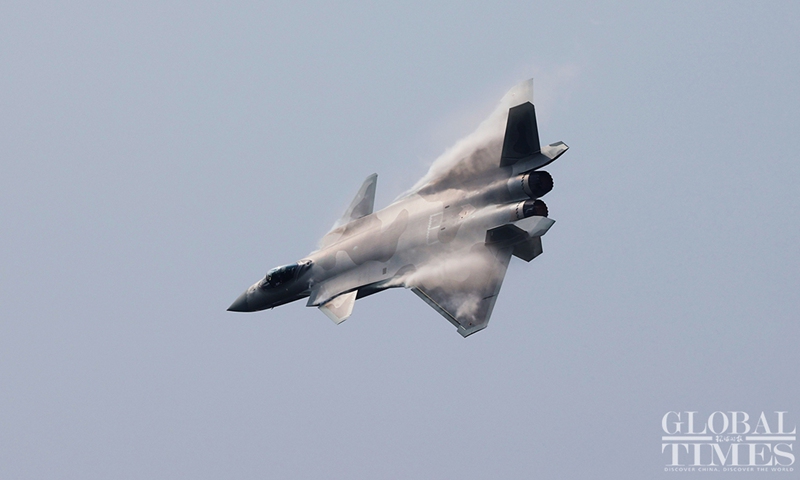
J-20 jets, China's most advanced stealth fighter jets powered by domestic engines, made their debut at the opening ceremony of the China Airshow 2021 in the host city Zhuhai, South China's Guangdong Province on Tuesday.Photo: Cui Meng/GT
China has reportedly conducted the maiden flight of the twin-seat variation of the J-20 recently, as the aircraft became the world's first stealth fighter jet with two seats to fly. Chinese military analysts said on Sunday that the new warplane uses innovations that could potentially change warfare and lead the world.
A two-seat prototype of the J-20 fifth-generation multirole fighter aircraft has conducted what appears to have been its maiden flight, UK-based Jane's Defence Weekly reported on Friday, citing an image that emerged on the same day on social media platforms.
According to the undated photo, the prototype aircraft was painted in yellow primer, and it took off from the airfield of the Chengdu Aircraft Industry Group, the maker of the J-20, next to its production facility, the Jane's report said.
The Jane's report came after unverified photos and videos circulated on social media in late October, which gave the world the first glimpse of the long-rumored aircraft running taxiing trials at the same airfield. Taxiing trials are often conducted shortly before test flights.
If the report is true, it would mean that the twin-seat variation of the J-20, sometimes informally dubbed the J-20S or J-20B since the official designation has yet to be released, has become the world's first stealth fighter jet with two seats to be developed and fly, observers said.
As the world's first of its kind, China's J-20S twin-seat stealth fighter jet could potentially change the layout of future battlefields, and inspire and lead other countries in developing their own next-generation stealth fighter jets, Fu Qianshao, a Chinese military aviation expert, said on social media on Saturday.
China used to follow the lead of other countries in warplane development, but it caught up with them with the original J-20, Fu said, noting that when China uses innovations like it does with the J-20S, it could lead the world in aviation.
When asked about the twin-seat variant of the J-20, Yang Wei, chief designer of the aircraft, said at a press conference at Airshow China 2021 in late September that, "Assuming we do have a twin-seat version of the J-20, it would not be a trainer aircraft, because it would be developed for the enhancement of the aircraft."
Wang Ya'nan, the chief editor of Beijing-based Aerospace Knowledge magazine, told the Global Times on Sunday that an extra pilot on the twin-seat fighter jet could be utilized in more complicated combat situations, like serving as a fighter bomber and conducting attack missions on the ground and targets at sea, in addition to those in the air.
Another possibility is that the twin-seat version J-20 will be used to control loyal wingman-style drones, which will accompany the manned fighter in flight and carry different types of payloads for a wide variety of missions, including ground and surface attacks, air-to-air combat and electronic disruption, Wang said, noting that this would be a task too complicated for a single pilot to handle.
Combat data from the second seat could be gathered, analyzed and used to train artificial intelligence, which could eventually replace the second pilot, Wang predicted.




